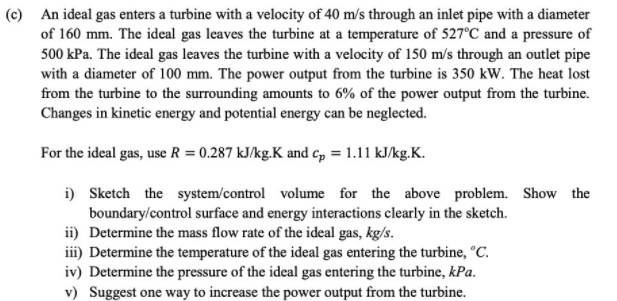An ideal gas enters a turbine with a velocity of 40 m/s through an inlet pipe with a diameter of 160 mm. The ideal gas leaves the turbine at a temperature of 527°C and a pressure of 500 kPa. The ideal gas leaves the turbine with a velocity of 150 m/s through an outlet pipe with a diameter of 100 mm. The power output from the turbine is 350 kW. The heat lost from the turbine to the surrounding amounts to 6% of the power output from the turbine. Changes in kinetic energy and potential energy can be neglected. For the ideal gas, use R = 0.287 kJ/kg.K and Cp = 1.11 kJ/kg.K. i) Sketch the system/control volume for the above problem. Show the boundary/control surface and energy interactions clearly in the sketch. ii) Determine the mass flow rate of the ideal gas, kg/s. iii) Determine the temperature of the ideal gas entering the turbine, °C.
An ideal gas enters a turbine with a velocity of 40 m/s through an inlet pipe with a diameter of 160 mm. The ideal gas leaves the turbine at a temperature of 527°C and a pressure of 500 kPa. The ideal gas leaves the turbine with a velocity of 150 m/s through an outlet pipe with a diameter of 100 mm. The power output from the turbine is 350 kW. The heat lost from the turbine to the surrounding amounts to 6% of the power output from the turbine. Changes in kinetic energy and potential energy can be neglected. For the ideal gas, use R = 0.287 kJ/kg.K and Cp = 1.11 kJ/kg.K. i) Sketch the system/control volume for the above problem. Show the boundary/control surface and energy interactions clearly in the sketch. ii) Determine the mass flow rate of the ideal gas, kg/s. iii) Determine the temperature of the ideal gas entering the turbine, °C.
Elements Of Electromagnetics
7th Edition
ISBN:9780190698614
Author:Sadiku, Matthew N. O.
Publisher:Sadiku, Matthew N. O.
ChapterMA: Math Assessment
Section: Chapter Questions
Problem 1.1MA
Related questions
Question

Transcribed Image Text:(c) An ideal gas enters a turbine with a velocity of 40 m/s through an inlet pipe with a diameter
of 160 mm. The ideal gas leaves the turbine at a temperature of 527°C and a pressure of
500 kPa. The ideal gas leaves the turbine with a velocity of 150 m/s through an outlet pipe
with a diameter of 100 mm. The power output from the turbine is 350 kW. The heat lost
from the turbine to the surrounding amounts to 6% of the power output from the turbine.
Changes in kinetic energy and potential energy can be neglected.
For the ideal gas, use R = 0.287 kJ/kg.K and c, = 1.11 kJ/kg.K.
i) Sketch the system/control volume for the above problem. Show the
boundary/control surface and energy interactions clearly in the sketch.
ii) Determine the mass flow rate of the ideal gas, kg/s.
iii) Determine the temperature of the ideal gas entering the turbine, °C.
iv) Determine the pressure of the ideal gas entering the turbine, kPa.
v) Suggest one way to increase the power output from the turbine.
Expert Solution
This question has been solved!
Explore an expertly crafted, step-by-step solution for a thorough understanding of key concepts.
Step by step
Solved in 4 steps with 1 images

Knowledge Booster
Learn more about
Need a deep-dive on the concept behind this application? Look no further. Learn more about this topic, mechanical-engineering and related others by exploring similar questions and additional content below.Recommended textbooks for you

Elements Of Electromagnetics
Mechanical Engineering
ISBN:
9780190698614
Author:
Sadiku, Matthew N. O.
Publisher:
Oxford University Press

Mechanics of Materials (10th Edition)
Mechanical Engineering
ISBN:
9780134319650
Author:
Russell C. Hibbeler
Publisher:
PEARSON

Thermodynamics: An Engineering Approach
Mechanical Engineering
ISBN:
9781259822674
Author:
Yunus A. Cengel Dr., Michael A. Boles
Publisher:
McGraw-Hill Education

Elements Of Electromagnetics
Mechanical Engineering
ISBN:
9780190698614
Author:
Sadiku, Matthew N. O.
Publisher:
Oxford University Press

Mechanics of Materials (10th Edition)
Mechanical Engineering
ISBN:
9780134319650
Author:
Russell C. Hibbeler
Publisher:
PEARSON

Thermodynamics: An Engineering Approach
Mechanical Engineering
ISBN:
9781259822674
Author:
Yunus A. Cengel Dr., Michael A. Boles
Publisher:
McGraw-Hill Education

Control Systems Engineering
Mechanical Engineering
ISBN:
9781118170519
Author:
Norman S. Nise
Publisher:
WILEY

Mechanics of Materials (MindTap Course List)
Mechanical Engineering
ISBN:
9781337093347
Author:
Barry J. Goodno, James M. Gere
Publisher:
Cengage Learning

Engineering Mechanics: Statics
Mechanical Engineering
ISBN:
9781118807330
Author:
James L. Meriam, L. G. Kraige, J. N. Bolton
Publisher:
WILEY